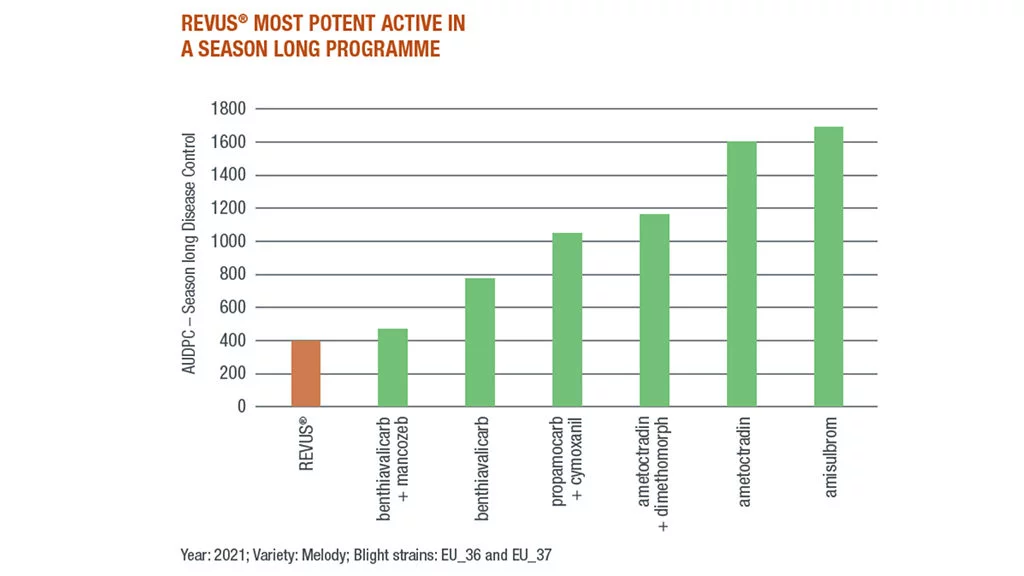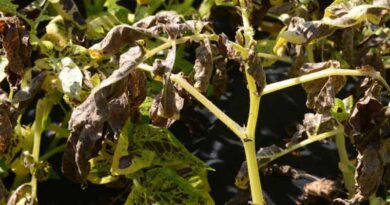Mix strategy to counter blight resistance risks
Potato growers can manage the increasing incidence of blight resistance with effective fungicide mixing strategies, and still retain the benefits of utilising the most potent chemistry to protect crops, advises Syngenta Technical Manager, Andy Cunningham.
23 February 2024, UK: Speaking at the Potato Science Live events this spring, he’ll highlight how the mandipropamid mixing strategy enabled growers and agronomists in Denmark to dramatically reduce the outbreaks of CAA compromised blight strain EU 43 from over 70% of recorded cases in 2022, to less than 20% of outbreaks last season.
As a result, the recommendations for the use of Revus in Denmark have increased by over 60% for this season, from two applications per crop to five, with a range of fungicide mixes.
“UK growers are in a far more fortunate position, given that the EU 43 strain has never been sampled in blight monitoring programmes, and they have many more options available for mix partners that will enable them to reliably use Revus in this season’s programmes.”
Andy reminds growers that Revus has consistently proven the most potent blight fungicide for protection through the most important early and mid-canopy phase, outside of OXTP – with news that this too has now been compromised with resistance in the European blight population.
“There has been an emergence of a new blight genotype, EU_46, in the Netherlands,” he reported. “We still need to understand what impact it will have. However, due to our understanding of the resistance mechanism to CAA chemistry, there is a very good chance this new strain will be sensitive to Revus, meaning mandipropamid becomes the solution to the issue,” he said.

To ensure Revus retains its full efficacy, and to avoid selecting for any resistant strains, should they arrive in the UK, Andy advocates it should always be used in mix with a complementary blight fungicide with an alternative mode of action.
Furthermore, the partner must be used at a rate that will give protection equal in duration to Revus in the blight programme schedule.
He cites suitable partners for Revus in the UK for the 2024 season include mancozeb, fluazinam, propamocarb and cyazofamid, as well as the leading contender, amisulbrom.
“There is potentially a role for cymoxanil to give kick-back activity, in the event of a weather delayed application, but in our Eurofins blight trials there was indication that it may not give the desired duration of protection – so intervals would have to be tightened,” he suggested.
Andy reported the robust resistance breaking strategy of fungicide mixing had been proven in the Eurofins trial, even in an inoculated and infection cultivated trial with the fluazinam resistant EU 37 strain, a season-long programme of fluazinam – mixed with a range of partners, maintained full or high levels of control.
“The experience of the research at Eurofins, along with R&D in Europe, has given confidence that with appropriate mixing strategies we can both minimise the risk of resistant blight strains established in the UK, and still get beneficial effects from compromised chemistry should it occur.
“Potato growers and agronomists need to take a responsible approach to planning this season’s blight strategy, and still take full advantage of the benefits of Revus for highly effective foliar blight control and, by keeping the crop clean, minimising the risk of tuber blight spread.”
The combination of mandipropamid and amisulbrom could prove especially valuable, targeted at the reduction of tuber blight risks.
Also Read: Corteva Agriscience launches new nematicide Salibro™ in India
(For Latest Agriculture News & Updates, follow Krishak Jagat on Google News)














